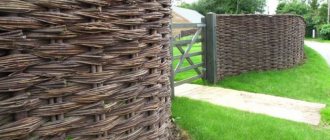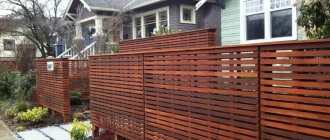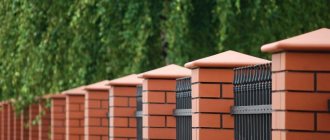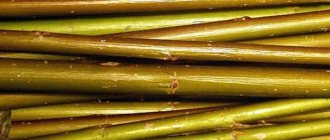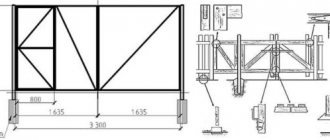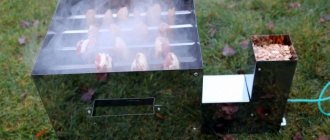Many people mistakenly believe that decorating a personal plot is an expensive pleasure, and that creating unusual fences requires the assistance of a professional designer. There is also a stereotype that a fence attracts unwanted attention and requires special care. However, you can often make an area irresistible with your own hands, using available materials. One example is the willow wattle that forms the property's fencing. It will harmoniously fit into the landscape design, made in a rustic style, and will add color to the house. The only possible problem with this is the search and preparation of material of suitable quality. As for weaving technology, it can be easily mastered at home.
What to make a fence from
Today, you can weave a fence not only from natural branches, but also from artificial polymers. The following branches are suitable for work from natural materials:
- and you;
- hazel;
- grapes;
- fruit trees (mulberries, cherries, cherries).
If there is a body of water near the site, you can make a fence from reeds or cattails. Their young stems are long and bend well.
“Austrian wicker” is made from thin pine boards. The thickness of 2-2.5 cm allows the boards to bend around the supports, and the finished canvas is very reliable.
Frame installation
To make a fence frame, steel rods are driven into the ground at equal distances. These rods are painted in the color of wood so that their metal origin is not visible. Such a steel base is much more reliable than a wooden one, because it will not rot deep underground.
You can, of course, use wooden stakes, however, you must first treat them with an antiseptic. To do this, pour drying oil into the hole. To prevent the wood from rotting, the stakes can be immersed in a steel pipe, or a plastic attachment can be made for them.
Return to contents
How to prepare rods
Before you make a fence from the vine, you need to prepare it in sufficient quantities. It is recommended to cut twigs (1-3 cm in diameter) in early spring, before the active movement of juices begins. Use sharp pruning shears and cut the shoots at an angle.
But even in the summer, when sap flow slows down due to dry, hot weather, you can cut branches for collection. It is especially successful to prune trees after they have increased the length of their shoots in the spring and produced a harvest in the summer.
You can make a wattle fence from either freshly cut or pre-prepared branches. The cut rods remain flexible enough to work for a week. This is the easiest option - cut and use immediately.
Or you can treat the rods before weaving: remove the bark, paint. This way, a wicker fence made of wicker will have a neater appearance, and its service life will increase.
To remove the bark, the branches are steamed and the top layer is removed with a special tool - a “pinch.” Brown is most often painted with stain or potassium permanganate.
You can bleach the rods with hydrogen peroxide. A solution of iron sulfate will give a gray color.
Preparatory manipulations
In the warm season, raw materials without skin are immediately dried in the sun, laying sticks on a boardwalk. The material cannot be piled in piles, otherwise it will become stained in places. The twigs should lie separately from each other. In rainy weather, the vine can be laid out under a canopy. In sunny weather, 2 days are enough to dry the willow; in bad weather, it will take about a week.
Workpieces should be stored at temperatures from 0 to +40 in the attic or basement
Artificial materials for weaving
Polymer wicker is an artificial polyethylene fiber. For sale:
- separate whips tied into bundles;
- already woven fragments in a metal frame.
A fence made of polymer wicker can be assembled like a construction set by connecting ready-made frames together. The artificial wicker looks neat, the rods are the same in thickness and can be painted in any color (or different colors) at the request of the customer.
It lasts a long time and does not deteriorate from frost, rain and wind. But it does not have a pristine natural appearance.
White climber or almond willow
The vine of this variety of willow is most suitable for weaving. The plant looks like a small tree or shrub. Recognized by its brown bark with a yellow or green tint. Whitecrest grows on moist soils and peat bogs. The main advantage of almond willow, important for creating a wattle fence, is the simple splitting and convenient removal of the bark. Steam treatment gives the material an attractive bronze tint.
Stages of weaving a fence
- Dig holes along the perimeter of the fence at a distance of 50 cm. The depth depends on the planned height of the fence. For a fence 1.5 m high, the supports need to be dug 50 cm, for a fence 1 m high - 30 cm. The pegs of decorative low partitions are driven in 15-20 cm.
- Pour sand or a mixture of crushed stone and sand into the holes so that excess moisture can drain freely and not soak the structure.
- Install the supports, having previously treated them with an antifungal compound.
- Place the rods one after another between the supports. If necessary, the wide ends can be tied to the supports with wire; the narrow ends can simply be hidden deep into the already laid layers. To make the weaving tight, the rods need to be tapped with a hammer every 3-4 rows.
- If the rods are thin, you can weave several of them into the fence at a time. This will speed up the work.
- It is advisable to coat the finished wattle fence with acrylic varnish.
Laurel willow
A mature tree can reach 14 m in height, so the master will have to climb up to get good twigs. However, the work is worth it - long-lasting fences are made from laurel willow. The plant chooses wet meadows and peatlands as its habitat. Its bark is dark green. The thick, durable core allows you to weave strong, reliable fences from laurel-leaved willow.
Weaving options
In addition to simple horizontal weaving, when the branches are intertwined one at a time, there are other, more complex and elegant methods. From the photo of a wicker fence and diagrams, it is very easy to understand the principle of weaving.
There is a vertical weave reminiscent of medieval military barriers. It will require vertical pegs and horizontal supports through which the branches will intertwine.
There is a horizontal braiding pattern that follows the principle of laying hair strands.
The diagonal arrangement of the rods has also proven itself well. Depending on how close to each other they are located, you can get a strong shield or an openwork hedge.
Overview of the main types of wood
The best wattles are obtained from one- or two-year-old willow shoots. Young growth is distinguished by such properties as strength and elasticity, tendency to bend and resistance to fractures. It is these characteristics that make it possible to weave high-quality fences. Harvesting twigs should be done closer to winter or at the very beginning of spring, while the trees are in the hibernation stage.
A suitable willow for weaving a fence is selected from the following varieties:
- Almond willow "whitebush";
- Red-flowered willow "talnik";
- Hemp willow;
- Laurel willow;
- Goat willow.
Decoration and additions
You can not only make a vine fence with your own hands, but also decorate it. Often this also does not require funds. For example, clay jugs and jars are classics for framing wickerwork.
Climbing annual and perennial flowers and decorative grapes feel great near the fence. But the clinging greenery is not to everyone’s taste, because it disguises the fence itself.
Without covering the wickerwork, you can spot-plant sunflowers and hollyhocks next to it. In the open space they will grow lush, tall and decorate the fence. In addition to flowers, creeping varieties of blackberries, peas and beans will feel good next to the fence.
Developing a country theme on your site, you can place an old cart wheel or a stone millstone next to the fence. And if you add a few more unpolished stones and greenery, then a whole rockery will form near the fence.
But crafts made from plastic bottles and other improvised materials, beloved by many summer residents, do not combine with natural wicker.
What varieties of willow exist and which ones are suitable for hedges?
Not every willow is suitable for a fence. Of the 600 species of willow, designers and summer residents use the following for hedges.
White
It is better known as willow. Most suitable for hedges in a large garden. Loves moist soil. It grows up to 31 meters in height, but is brittle and therefore not suitable for tunnels. The leaves are pointed. It blooms in April, and seeds appear on it already in June. In urban conditions, it can live up to 100 years.
Willow is a typical species of deciduous tree.
Purple
Shrub up to 4 meters high. The shoots and earrings are purple, and the leaves have a bluish tint. The flowers are honey-bearing and attract many bees. Purple willow lives a long time. A fence made from it will last for 30 years, no less.
Photo: zoning the site using purple willow
Holly
Requires the least amount of maintenance and is most often used for hedges. Its height reaches 8 meters. It loves moist soil, but does not tolerate stagnant moisture, so it needs drainage. Grows well in poor soils and sandy soils. The twigs of this type of willow are used to weave furniture, baskets, and decorative elements.
Photo: Krasnotal, aka Red Willow, aka Shelyuga
Goat
It grows up to 10 meters, does not tolerate swampy soil, so when planting it requires good drainage. The male bush has red catkins.
Photo: Bredina, or Rakita or Willow Hultena - a tree or tree-like shrub.
Mesh
Dwarf willow variety. It is used for garden landscaping and is not suitable for a full-fledged hedge due to its small height, only 40 cm.
Photo: creeping shrub
Sakhalinskaya
This willow is suitable for hedges in areas where winters are frosty. Grows up to 4 meters in height.
Ural sinuous
Willow with very branchy shoots that give it a decorative appearance. Beautiful man-made hedges from this variety are obtained on the sunny side of the site, but this shrub grows slower than others.
Dwarf willow
This is another small shrub that does not grow higher than 30 cm. It is used to make living borders and small fences for zoning an area. Due to its size, it is not suitable for hedges. Dwarf willow can be given any shape by pruning. The spherical composition looks good.
Photos of beautiful vine fences
Varieties of braiding
Today, products made from PVC are of great interest. The work is quite easy, the result looks beautiful.
Wicker fencing, the material of which is PVC, has a number of advantages:
- Easy assembly;
- Quick installation;
- There is no need to make a foundation;
- Long service life;
- High impact resistance;
- Never fades;
- Does not need repair;
- No painting needed.
On the construction market for such a fence the following is offered:
- Plastic mesh;
- Gitter grid;
- Separate sections.
All these products can be installed very quickly.
Return to contents
How to paint the fence?
To make the fence look more beautiful, it should be painted. In addition, this reduces contamination of the fence.
If you use manganese solution or stain, the fence will turn brown.
Using iron sulfate, you can achieve a gray color.
For white color, the fence is treated with hydrogen peroxide.
In addition to these materials, the fence can be varnished.
To ensure that the fence can be used for as long as possible, it is coated with natural dye.
Subtleties of work
Before starting work, you should fully familiarize yourself with the rules of working with wood and learn how to prepare it.
To increase the life of the fence, it is recommended to use metal stakes. The rods are tied with wire in several places, otherwise they will break, and then the entire structure will have to be disassembled.
If you approach your work responsibly and follow all the recommendations, you can get a beautiful decoration for your garden.
Painting a wicker fence
In order to make the fence even more attractive, as well as protect it from dirt and dust, it is recommended to cover the surface of the vine with a certain solution. Often such tools are available in every home.
Here is their list:
- manganese;
- stain;
- inkstone;
- Matt lacquer.
Before applying the product, the rods must be cleared of bark and treated with hydrogen peroxide, it will work as a brightener.
